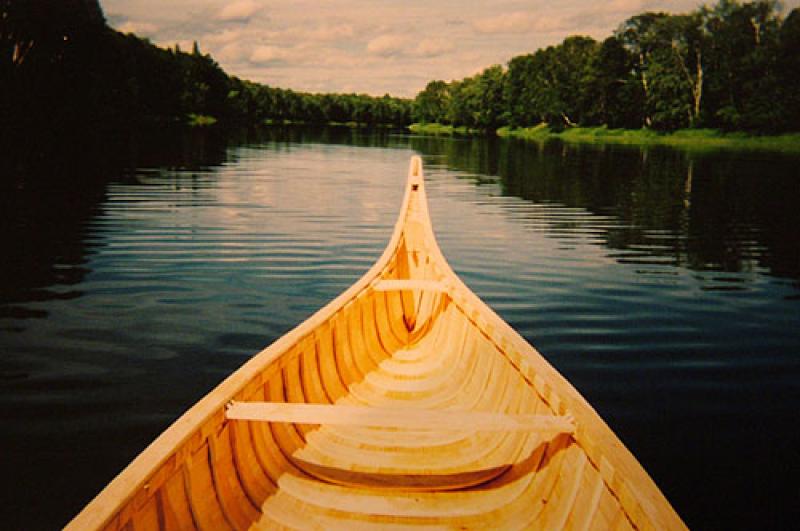The Birchbark Canoe, A Sustainable Design Classic
By: Eric Nayon

The Birchbark Canoe, A Sustainable Design Classic
These works of art and feats of engineering are central to Canadian and First Nations history - and the craft of birchbark canoe-making is still alive and well.

Like the beaver, maple syrup, politeness and hockey, the canoe has sadly descended from valued cultural icon to pure kitsch for those who peddle Canadiana kitsch. So it was refreshing to see the canoe in its proper light in Peterborough, Ontario at the Canadian Canoe Museum. The museum's diverse collection of canoes spoke of the historical and cultural importance of the venerable watercraft and its connection to Canada's and First Nations' history.
Like the beaver, maple syrup, politeness and hockey, the canoe has sadly descended from valued cultural icon to pure kitsch for those who peddle Canadiana kitsch. So it was refreshing to see the canoe in its proper light in Peterborough, Ontario at the Canadian Canoe Museum. The museum's diverse collection of canoes spoke of the historical and cultural importance of the venerable watercraft and its connection to Canada's and First Nations' history.
The replica of a monster birchbark trading canoe used by the Hudson Bay Company placed on display next to the lithe birchbark canoes of the Chippewa, Cree, Algonquin, Krunaxa and others got me thinking about the birchbark canoe as the sustainable design solution par excellence . The synchronization of the rhythms of human life and the rhythms of nature coupled with the elegance of the birchbark canoe's diverse forms were as much a part of canoe building as its practical design constraints like buoyancy, navigability and waterproofing.

First Nations artisans evolved many variations of the birchbark canoe using local materials and sustainable harvesting methods to meet their design performance needs. Materials like bear grease and spruce gum served as ideal sealants and designs were always fundamentally practical in intent. Jeremy Ward, curator of the Canadian Canoe Museum, pointed out that the availability of birch bark, the need for portable boats and an impassable landscape led to a relationship with the canoe that was unique to the upper half of North America, and birchbark emerged as an ideal material.
Canoe building still remains a sacred and valued art, but where and how are the traditions, craft and rituals of birchbark canoe making being kept alive? Luckily, the answer is in many places and in many forms - both traditional and contemporary.
Tom Byers is a Metis craftsman living in Whitefish, Ontario who has been making birchbark canoes since 1994 on the banks of the Vermilion River near Killarney Wilderness Park. Tom lives in a small hand-hewn log cabin with no running water, no electricity and no telephone and makes his canoes using traditional skills and practices. Tom uses just a few simple tools, such as the crooked knife, froe, hatchet, wood mallet, awl and shaving horse in his work. His process incudes collecting materials from the forest and then hand building each canoe, which takes a minimum of 350 hours to complete.
A typical canoe consists of selected high grade birch bark, over 35 hand-split cedar ribs, 50 wafer-thin strips of cedar sheathing, full-length gunwales and caps, deck ends, birch thwarts, about 500 feet of spruce or jack pine root lacing, and two quarts of waterproofing made from spruce gum and bear fat. The variability of the natural materials means that each canoe's shape and character is always unique and no two canoes will ever be alike.

Tom's work also includes building canoes with youth from places like the Serpent River First Nation.
There are also many contemporary methods for learning about birchbark canoe making, including Native Art in Canada , a website sponsored by Ojibwe Elders and dedicated to the art and stories of the Ojibwe. The site lays out step-by-step directions on how to build a traditional birchbark canoe. Instructional videos are also available on YouTube: originally an episode of Ray Mears' Bushcraft , this video follows the entire process of building a birchbark canoe over a nine-day period as Ray is guided by an Algonquin canoe builder from the Pikwakanagan Reserve in Golden Lake, Ontario.
Publications and organizations like Wooden Canoe Journal , the Wooden Canoe Heritage Association and the Native Watercraft Society are also options. "Building Birchbark Canoes" by Rick Nash in The Canoe: A Living Tradition is a good resource too.
Observing and participating in the construction of a birchbark canoe is undoubtedly the most effective means for understanding and experiencing the art and ritual of birchbark canoe making. This summer at my own university a traditional Algonquin birch bark canoe was constructed in a classroom in downtown Toronto. The final product came together after a year-long period of gathering and harvesting materials and was constructed with the guidance of Algonquin canoe builder Chuck Commanda and his wife, Janet Commanda, along with a cast of others, including OCADU students.
It was a humbling and surreal experience to see a traditional birch bark canoe being built in downtown Toronto. I soon learned that this canoe would later be portaged through the city and placed in Lake Ontario. This canoe was also part of a much larger project called the Great Lakes Canoe Journey, which can be followed on Facebook, and demonstrates how traditional birchbark canoes can serve as effective vehicles for appreciating the environment in an age that has almost entirely forgotten about indigenous and vernacular design.
Eric Nay
Eric Nay is an architect, designer, artist and a professor at OCAD University. His blog, Made in Canada , profiles examples of Canadian design innovation, including sustainable buildings and design, craft practices and innovative businesses across the country.
No politics, no religion, no instagrams, and commentary must be civil. The ToS and the CoC will be enforced, and anything that the administrator deems to be offensive will be deleted. YouTubes, videos and images that the administrator is unable to open must be described and explained or they will be deleted.






It is hard for me to believe that ANY article about hand-building a canoe could be published without mentioning Cesar Newashish whom I stood and watched partially building one at the Mariposa Folk Festival so many years ago. The canoe he started there was finished by him and from that point on has been on display at the Royal Ontario Museum in Toronto.
Cesar Newashish in his canoe
Because of ALL the great comments that have been posted here complimenting the ingenuity and masterly skill of the Native Americans BEFORE European colonization this article should be pushed off the Front (Home) Page within the next day or so. In fact, what a surprise it hasn't disappeared already.
I don't know if you can open this but it is Cesar building a canoe.
Pretty amazing stuff
César's Bark Canoe - NFB
Yes, I can open it. It's an hour long so I'll watch it later.
I just watched it - it was fascinating to see such unbelievable hand skills - a true creative art. It embarrasses me to admit that my canoe was fiberglass.
So who, 10 to 8,000 years ago thought this was a good idea?
what a fascinating way to spend an hour
Answering your question, it was obviously that of the Native Americans.
Similar construction occurred around the world...
When it comes to birchbark canoes, much has been noted about the Native Americans. Do you have references that match it from elsewhere?
This is a cool topic.
The Ojibwe the inventors of the birch bark canoe were skilled seaman and used their BB canoes to defeat both the Sioux and the Mohawk in battles on Great Lakes. The BB canoe was used by the French and Europeans to move west since dugout and many other types of boats were too heavy and cumbersome to portage over shallow water. The largest of the canoes could hold up to 20 men and their supplies.
you never cut a birch tree down to get the bark to build them with. You learn to skin the bark with great care as not to damage the tree or the bark. The secret scrolls of the Ojibwe are birch bark and some are close to a thousand years old. Our housing pots water carriers are all made of birch bark. Strong durable and darn near indestructible.
many times I harvested wildrice with my dad and grandma in a birchbark canoe.
I have a model of one on my dresser. Made with all the proper material.
i have photos from the late 1800 and early 1900of birch bark canoes on Red Lake and much of northern MN.
You said to never cut the birch tree down to get the bark, but that's what Cesar did, as shown in the video. Do you have an all-in-one copier/printer/scanner that would enable you to scan those photos and post them here? Or is it possible to photograph the pictures so they can be saved in your computer's picture library and then posted?
I’m using my phone since my computer is down.
i can’t do much on the phone. I’ll give it a try.
this is from 1950 at Grand Portag MN.
My computer is a mess also, but that photo is pretty good.